Abstract
Two hypotheses are examined in the light of experience and the literature: (1) health service planning requires little epidemiological information, and (2) health services rarely get useful answers to relevant epidemiological questions. In the first hypothesis, the theoretical robustness of the concept of a minimum package of activities common to all facilities belonging to the same level of the system and the extent to which it is unaffected by variations in the frequencies of most diseases are examined. Semi-quantitative analyses and analysis of routine entries and participation suffice to adapt this package to the local context. Some of the methods which give a fundamental role to epidemiological information are criticized. With regard to the second hypothesis, the pertinent contributions epidemiology may make to health service organization are reviewed. These include identification of diseases that justify special activities (health maps and interepidemic surveillance), determination of the activities that should be added to the health centres, the political usefulness of rare impact assessments, and the relevant demographic elements. Finally an epidemiological agenda is proposed for specialized centres, districts, universities, and the central decision-making level of health ministries in developing countries.
Full text
PDF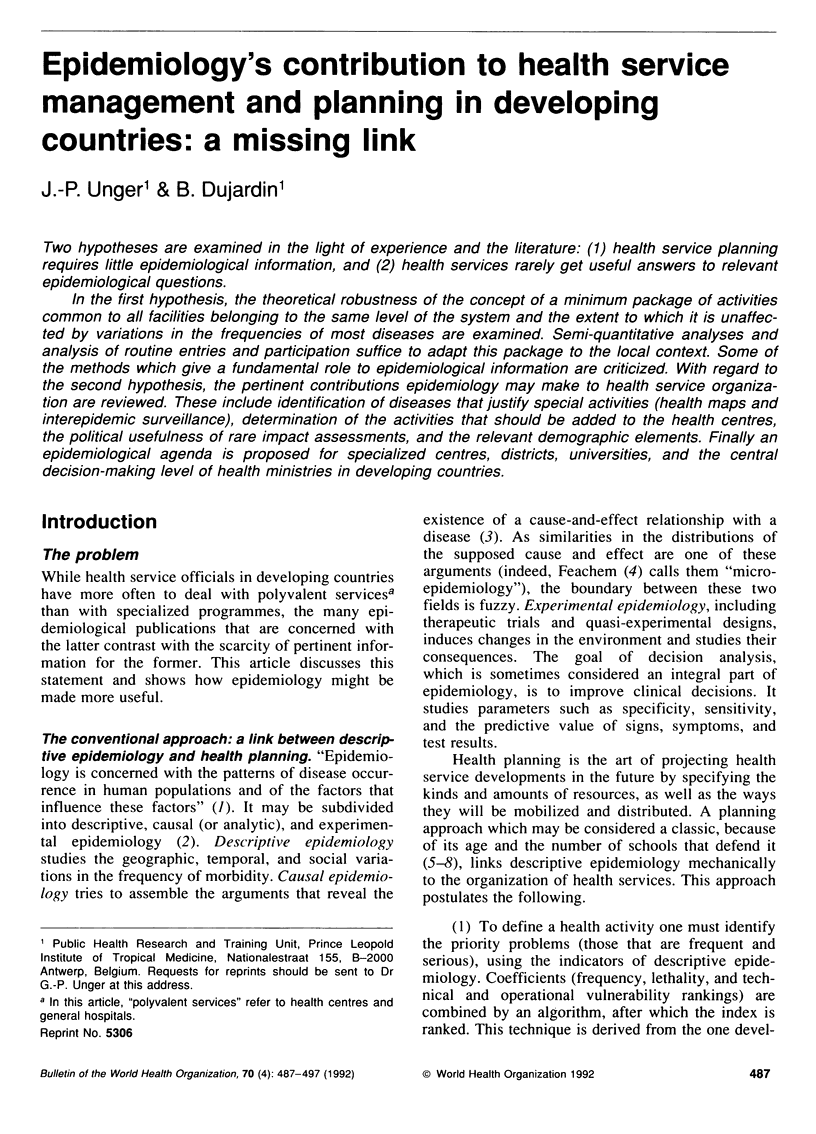
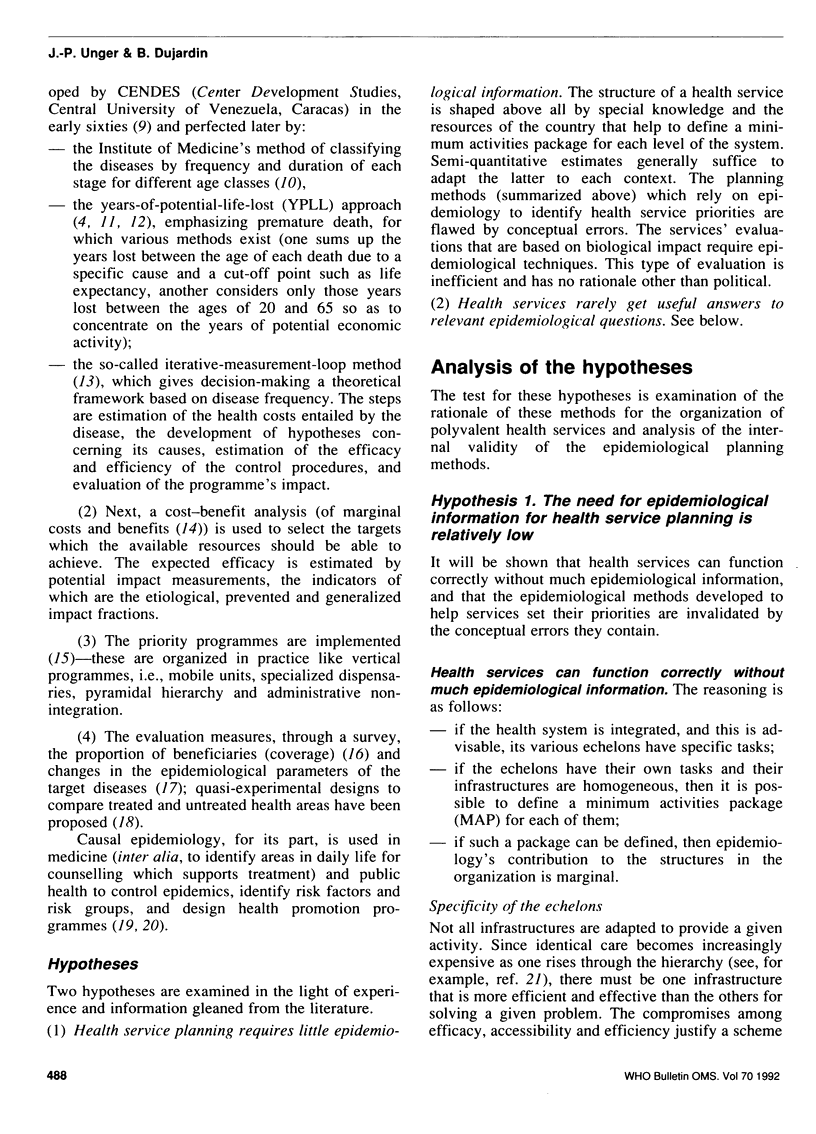


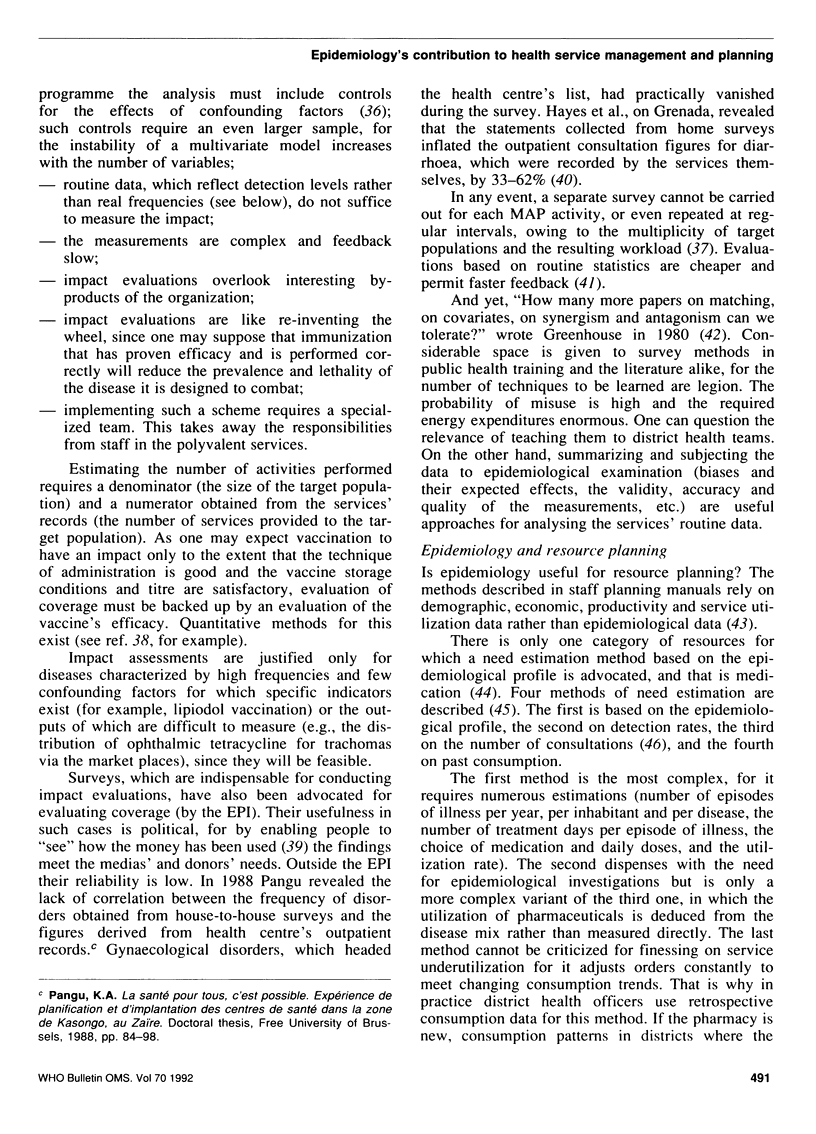
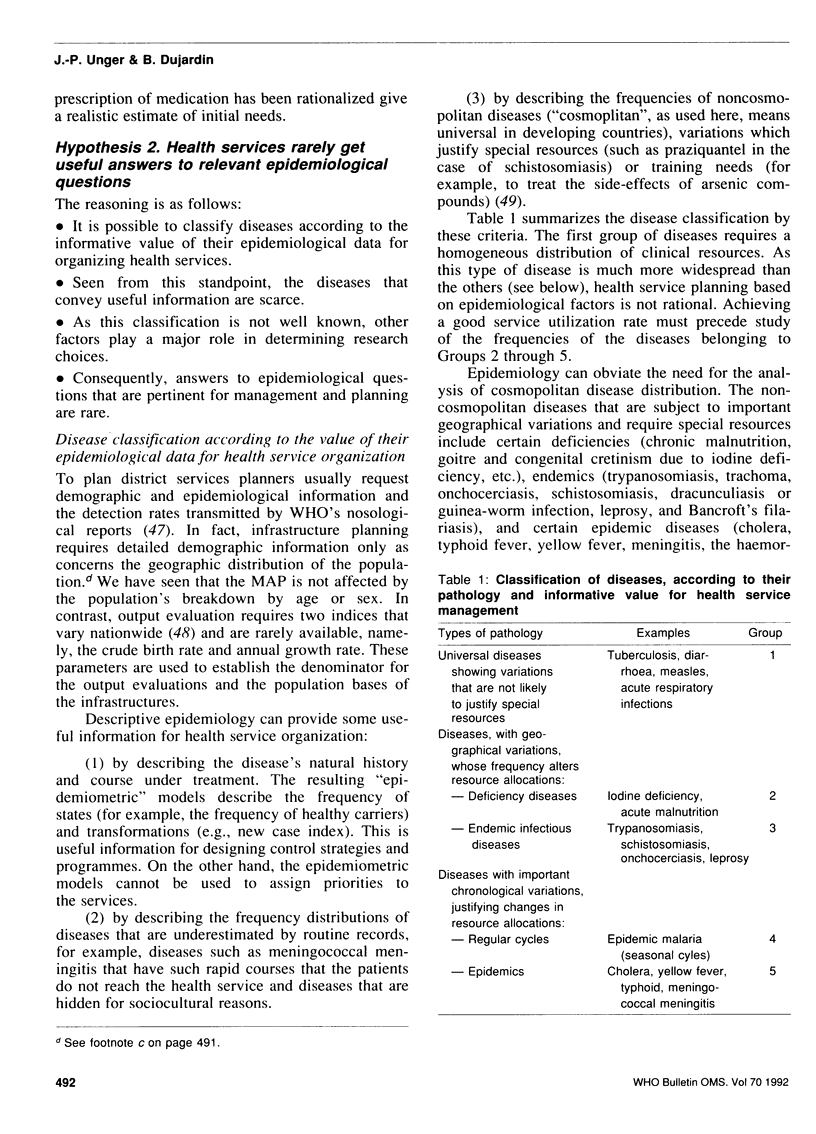


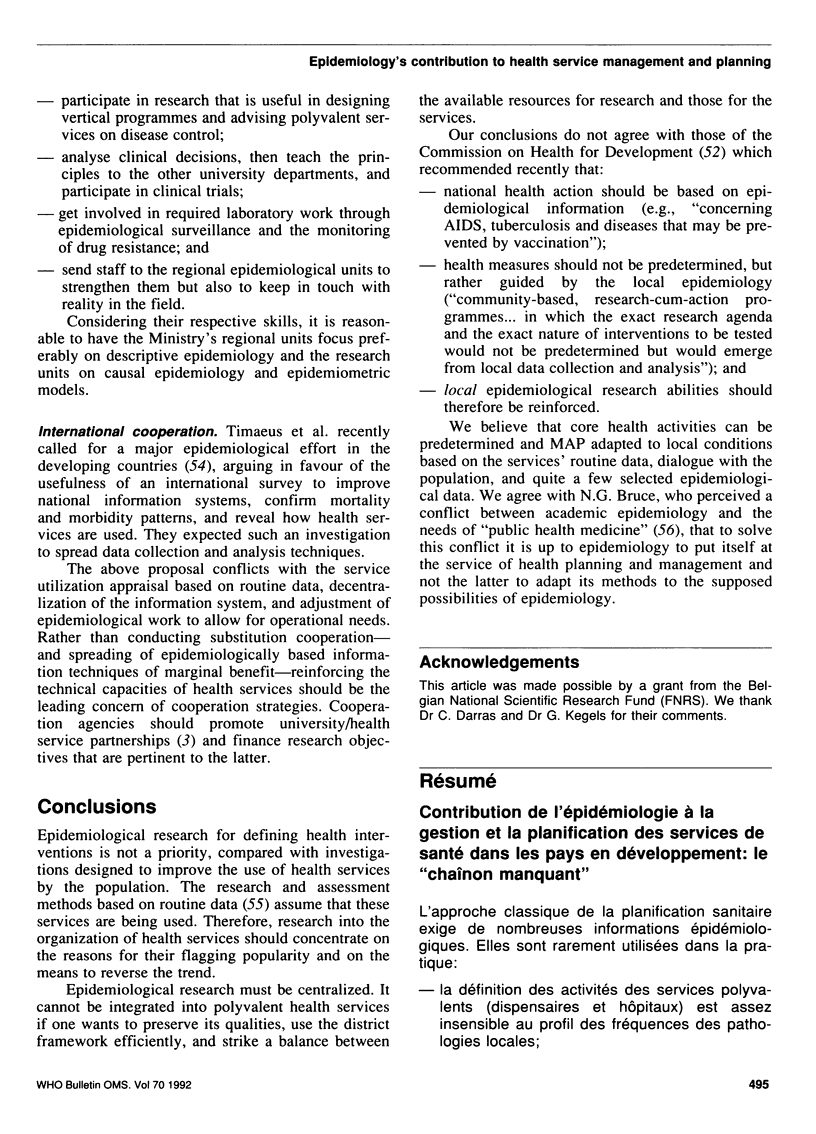
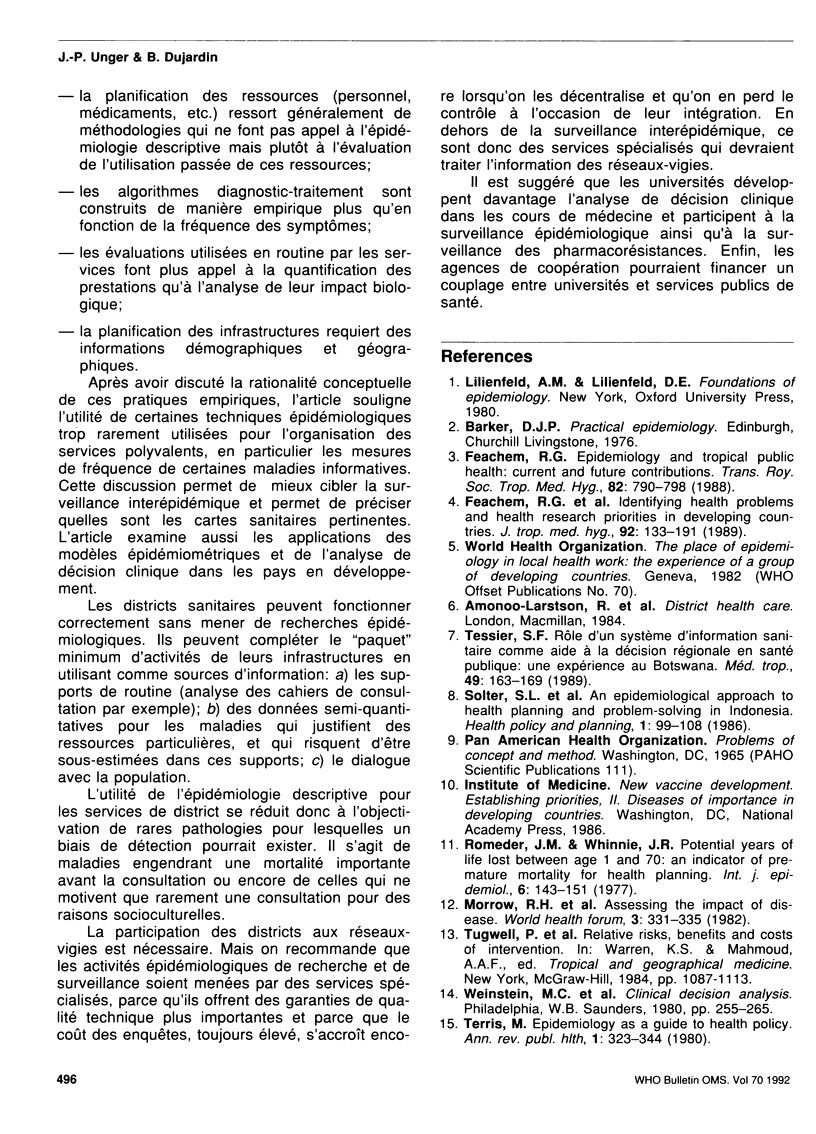
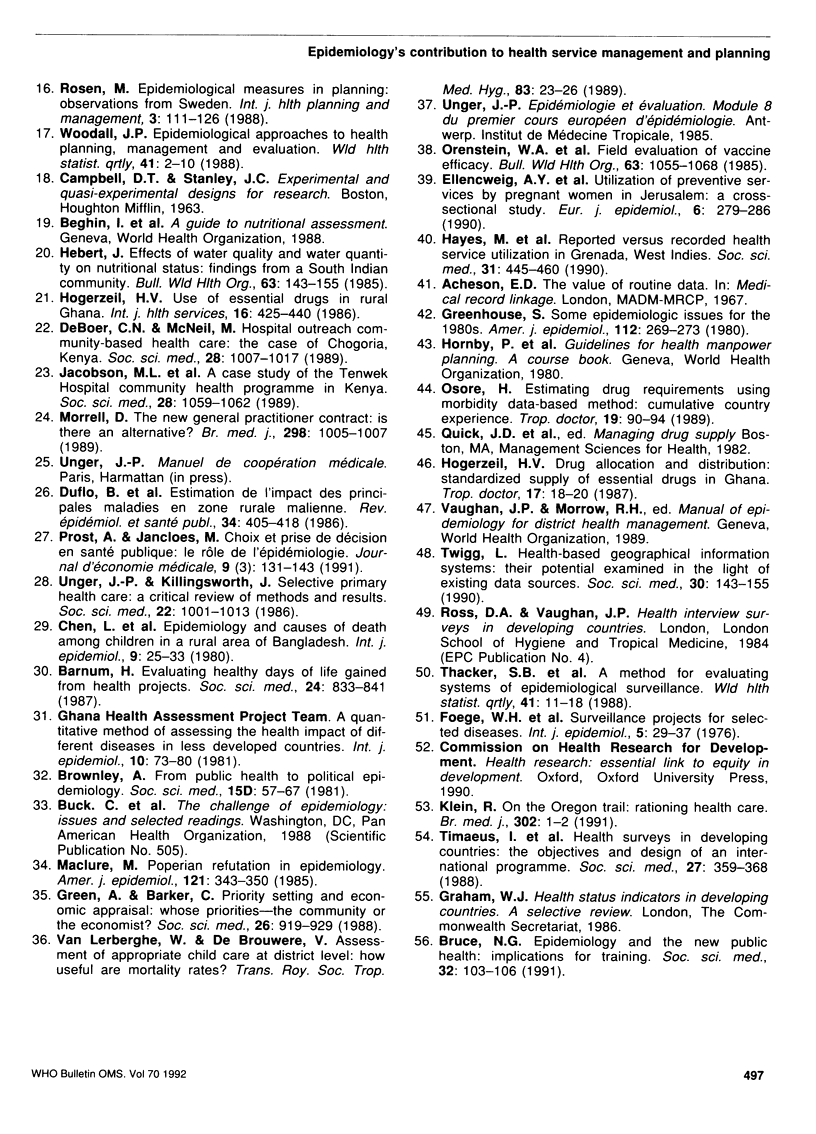
Selected References
These references are in PubMed. This may not be the complete list of references from this article.
- Barnum H. Evaluating healthy days of life gained from health projects. Soc Sci Med. 1987;24(10):833–841. doi: 10.1016/0277-9536(87)90184-5. [DOI] [PubMed] [Google Scholar]
- Bruce N. G. Epidemiology and the new public health; implications for training. Soc Sci Med. 1991;32(1):103–106. doi: 10.1016/0277-9536(91)90134-x. [DOI] [PubMed] [Google Scholar]
- Chen L. C., Rahman M., Sarder A. M. Epidemiology and causes of death among children in a rural area of Bangladesh. Int J Epidemiol. 1980 Mar;9(1):25–33. doi: 10.1093/ije/9.1.25. [DOI] [PubMed] [Google Scholar]
- DeBoer C. N., McNeil M. Hospital outreach community-based health care: the case of Chogoria, Kenya. Soc Sci Med. 1989;28(10):1007–1017. doi: 10.1016/0277-9536(89)90383-3. [DOI] [PubMed] [Google Scholar]
- Duflo B., Balique H., Ranque P., Diallo A. N., Brucker G., Alavi H., Prescott N. Estimation de l'impact des principales maladies en zone rurale malienne. Rev Epidemiol Sante Publique. 1986;34(6):405–418. [PubMed] [Google Scholar]
- Ellencweig A. Y., Ritter M., Peleg-Olavsky E., Tamir D. Utilization of preventive services by pregnant women in Jerusalem--a cross sectional study. Eur J Epidemiol. 1990 Sep;6(3):279–286. doi: 10.1007/BF00150433. [DOI] [PubMed] [Google Scholar]
- Feachem R. G. Epidemiology and tropical public health: current and future contributions with particular emphasis on the role of the London School of Hygiene and Tropical Medicine. Trans R Soc Trop Med Hyg. 1988;82(5):790–798. doi: 10.1016/0035-9203(88)90238-6. [DOI] [PubMed] [Google Scholar]
- Feachem R. G., Graham W. J., Timaeus I. M. Identifying health problems and health research priorities in developing countries. J Trop Med Hyg. 1989 Jun;92(3):133–191. [PubMed] [Google Scholar]
- Foege W. H., Hogan R. C., Newton L. H. Surveillance projects for selected diseases. Int J Epidemiol. 1976 Mar;5(1):29–37. doi: 10.1093/ije/5.1.29. [DOI] [PubMed] [Google Scholar]
- Green A., Barker C. Priority setting and economic appraisal: whose priorities--the community or the economist? Soc Sci Med. 1988;26(9):919–929. doi: 10.1016/0277-9536(88)90412-1. [DOI] [PubMed] [Google Scholar]
- Greenhouse S. W. Some epidemiologic issues for the 1980s. Am J Epidemiol. 1980 Aug;112(2):269–273. doi: 10.1093/oxfordjournals.aje.a112993. [DOI] [PubMed] [Google Scholar]
- Hayes M. V., Taylor S. M., Bayne L. R., Poland B. D. Reported versus recorded health service utilization in Grenada, West Indies. Soc Sci Med. 1990;31(4):455–460. doi: 10.1016/0277-9536(90)90040-y. [DOI] [PubMed] [Google Scholar]
- Hebert J. R. Effects of water quality and water quantity on nutritional status: findings from a south Indian community. Bull World Health Organ. 1985;63(1):145–155. [PMC free article] [PubMed] [Google Scholar]
- Hogerzeil H. V. Drug allocation and distribution. Standardized supply of essential drugs in Ghana--3. Trop Doct. 1987 Jan;17(1):18–20. doi: 10.1177/004947558701700109. [DOI] [PubMed] [Google Scholar]
- Hogerzeil H. V. Use of essential drugs in rural Ghana. Int J Health Serv. 1986;16(3):425–440. doi: 10.2190/LLHV-Y1FV-BKJG-4XTL. [DOI] [PubMed] [Google Scholar]
- Jacobson M. L., Labbok M. H., Parker R. L., Stevens D. L., Carter S. A. A case study of the Tenwek hospital community health programme in Kenya. Soc Sci Med. 1989;28(10):1059–1062. doi: 10.1016/0277-9536(89)90388-2. [DOI] [PubMed] [Google Scholar]
- Maclure M. Popperian refutation in epidemiology. Am J Epidemiol. 1985 Mar;121(3):343–350. doi: 10.1093/oxfordjournals.aje.a114005. [DOI] [PubMed] [Google Scholar]
- Morrell D. The new general practitioner contract: is there an alternative? BMJ. 1989 Apr 15;298(6679):1005–1007. doi: 10.1136/bmj.298.6679.1005. [DOI] [PMC free article] [PubMed] [Google Scholar]
- Osore H. Estimating drug requirements using morbidity data-based method: cumulative country experience. Trop Doct. 1989 Apr;19(2):90–94. doi: 10.1177/004947558901900216. [DOI] [PubMed] [Google Scholar]
- Romeder J. M., McWhinnie J. R. Potential years of life lost between ages 1 and 70: an indicator of premature mortality for health planning. Int J Epidemiol. 1977 Jun;6(2):143–151. doi: 10.1093/ije/6.2.143. [DOI] [PubMed] [Google Scholar]
- Rosén M. Epidemiological measures in planning: observations from Sweden. Int J Health Plann Manage. 1988 Apr-Jun;3(2):111–126. doi: 10.1002/hpm.4740030205. [DOI] [PubMed] [Google Scholar]
- Terris M. Epidemiology as a guide to health policy. Annu Rev Public Health. 1980;1:323–344. doi: 10.1146/annurev.pu.01.050180.001543. [DOI] [PubMed] [Google Scholar]
- Tessier S. F. Rôle d'un système d'information sanitaire comme aide à la décision régionale en santé publique. Une expérience au Botswana (Afrique Australe). Med Trop (Mars) 1989 Apr-Jun;49(2):163–169. [PubMed] [Google Scholar]
- Thacker S. B., Parrish R. G., Trowbridge F. L. A method for evaluating systems of epidemiological surveillance. World Health Stat Q. 1988;41(1):11–18. [PubMed] [Google Scholar]
- Timaeus I., Harpham T., Price M., Gilson L. Health surveys in developing countries: the objectives and design of an international programme. Soc Sci Med. 1988;27(4):359–368. doi: 10.1016/0277-9536(88)90270-5. [DOI] [PubMed] [Google Scholar]
- Twigg L. Health based geographical information systems: their potential examined in the light of existing data sources. Soc Sci Med. 1990;30(1):143–155. doi: 10.1016/0277-9536(90)90337-r. [DOI] [PubMed] [Google Scholar]
- Unger J. P., Killingsworth J. R. Selective primary health care: a critical review of methods and results. Soc Sci Med. 1986;22(10):1001–1013. doi: 10.1016/0277-9536(86)90200-5. [DOI] [PubMed] [Google Scholar]
- Van Lerberghe W., De Brouwere V. Assessment of appropriate child care at district level: how useful are mortality rates? Trans R Soc Trop Med Hyg. 1989 Jan-Feb;83(1):23–26. doi: 10.1016/0035-9203(89)90692-5. [DOI] [PubMed] [Google Scholar]
- Woodall J. P. Epidemiological approaches to health planning, management and evaluation. World Health Stat Q. 1988;41(1):2–10. [PubMed] [Google Scholar]


